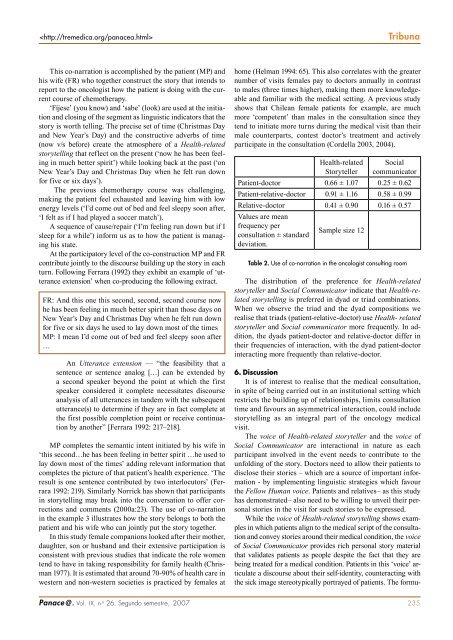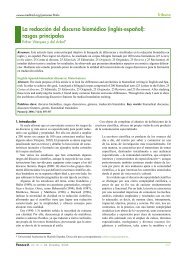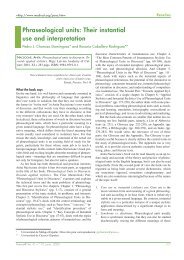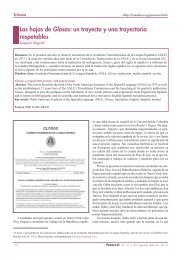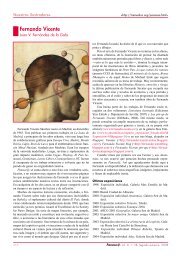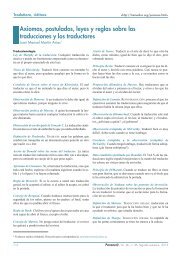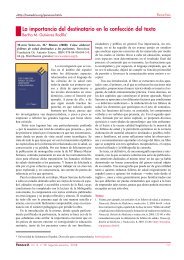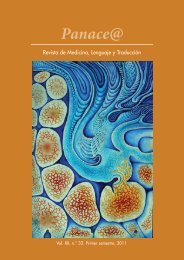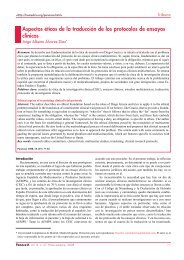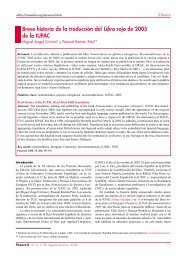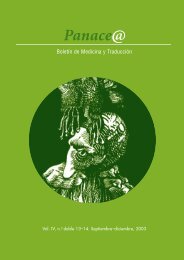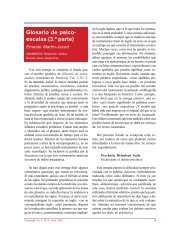Panace@ 26. Diciembre del 2007 - Tremédica
Panace@ 26. Diciembre del 2007 - Tremédica
Panace@ 26. Diciembre del 2007 - Tremédica
Create successful ePaper yourself
Turn your PDF publications into a flip-book with our unique Google optimized e-Paper software.
Tribuna<br />
This co-narration is accomplished by the patient (MP) and<br />
his wife (FR) who together construct the story that intends to<br />
report to the oncologist how the patient is doing with the current<br />
course of chemotherapy.<br />
‘Fíjese’ (you know) and ‘sabe’ (look) are used at the initiation<br />
and closing of the segment as linguistic indicators that the<br />
story is worth telling. The precise set of time (Christmas Day<br />
and New Year’s Day) and the constructive adverbs of time<br />
(now v/s before) create the atmosphere of a Health-related<br />
storytelling that reflect on the present (‘now he has been feeling<br />
in much better spirit’) while looking back at the past (‘on<br />
New Year’s Day and Christmas Day when he felt run down<br />
for five or six days’).<br />
The previous chemotherapy course was challenging,<br />
making the patient feel exhausted and leaving him with low<br />
energy levels (‘I’d come out of bed and feel sleepy soon after,<br />
‘I felt as if I had played a soccer match’).<br />
A sequence of cause/repair (‘I’m feeling run down but if I<br />
sleep for a while’) inform us as to how the patient is managing<br />
his state.<br />
At the participatory level of the co-construction MP and FR<br />
contribute jointly to the discourse building up the story in each<br />
turn. Following Ferrara (1992) they exhibit an example of ‘utterance<br />
extension’ when co-producing the following extract.<br />
FR: And this one this second, second, second course now<br />
he has been feeling in much better spirit than those days on<br />
New Year’s Day and Christmas Day when he felt run down<br />
for five or six days he used to lay down most of the times<br />
MP: I mean I’d come out of bed and feel sleepy soon after<br />
…<br />
An Utterance extension — “the feasibility that a<br />
sentence or sentence analog […] can be extended by<br />
a second speaker beyond the point at which the first<br />
speaker considered it complete necessitates discourse<br />
analysis of all utterances in tandem with the subsequent<br />
utterance(s) to determine if they are in fact complete at<br />
the first possible completion point or receive continuation<br />
by another” [Ferrara 1992: 217–218].<br />
MP completes the semantic intent initiated by his wife in<br />
‘this second…he has been feeling in better spirit …he used to<br />
lay down most of the times’ adding relevant information that<br />
completes the picture of that patient’s health experience. ‘The<br />
result is one sentence contributed by two interlocutors’ (Ferrara<br />
1992: 219). Similarly Norrick has shown that participants<br />
in storytelling may break into the conversation to offer corrections<br />
and comments (2000a:23). The use of co-narration<br />
in the example 3 illustrates how the story belongs to both the<br />
patient and his wife who can jointly put the story together.<br />
In this study female companions looked after their mother,<br />
daughter, son or husband and their extensive participation is<br />
consistent with previous studies that indicate the role women<br />
tend to have in taking responsibility for family health (Chrisman<br />
1977). It is estimated that around 70-90% of health care in<br />
western and non-western societies is practiced by females at<br />
home (Helman 1994: 65). This also correlates with the greater<br />
number of visits females pay to doctors annually in contrast<br />
to males (three times higher), making them more knowledgeable<br />
and familiar with the medical setting. A previous study<br />
shows that Chilean female patients for example, are much<br />
more ‘competent’ than males in the consultation since they<br />
tend to initiate more turns during the medical visit than their<br />
male counterparts, contest doctor’s treatment and actively<br />
participate in the consultation (Cor<strong>del</strong>la 2003, 2004).<br />
Health-related<br />
Storyteller<br />
Social<br />
communicator<br />
Patient-doctor 0.66 ± 1.07 0.25 ± 0.62<br />
Patient-relative-doctor 0.91 ± 1.16 0.58 ± 0.99<br />
Relative-doctor 0.41 ± 0.90 0.16 ± 0.57<br />
Values are mean<br />
frequency per<br />
consultation ± standard<br />
deviation.<br />
Sample size 12<br />
Table 2. Use of co-narration in the oncologist consulting room<br />
The distribution of the preference for Health-related<br />
storyteller and Social Communicator indicate that Health-related<br />
storytelling is preferred in dyad or triad combinations.<br />
When we observe the triad and the dyad compositions we<br />
realise that triads (patient-relative-doctor) use Health- related<br />
storyteller and Social communicator more frequently. In addition,<br />
the dyads patient-doctor and relative-doctor differ in<br />
their frequencies of interaction, with the dyad patient-doctor<br />
interacting more frequently than relative-doctor.<br />
6. Discussion<br />
It is of interest to realise that the medical consultation,<br />
in spite of being carried out in an institutional setting which<br />
restricts the building up of relationships, limits consultation<br />
time and favours an asymmetrical interaction, could include<br />
storytelling as an integral part of the oncology medical<br />
visit.<br />
The voice of Health-related storyteller and the voice of<br />
Social Communicator are interactional in nature as each<br />
participant involved in the event needs to contribute to the<br />
unfolding of the story. Doctors need to allow their patients to<br />
disclose their stories – which are a source of important information<br />
- by implementing linguistic strategies which favour<br />
the Fellow Human voice. Patients and relatives– as this study<br />
has demonstrated– also need to be willing to unveil their personal<br />
stories in the visit for such stories to be expressed.<br />
While the voice of Health-related storytelling shows examples<br />
in which patients align to the medical script of the consultation<br />
and convey stories around their medical condition, the voice<br />
of Social Communicator provides rich personal story material<br />
that validates patients as people despite the fact that they are<br />
being treated for a medical condition. Patients in this ‘voice’ articulate<br />
a discourse about their self-identity, counteracting with<br />
the sick image stereotypically portrayed of patients. The formu-<br />
<strong>Panace@</strong>. Vol. IX, n .o <strong>26.</strong> Segundo semestre, <strong>2007</strong> 235


